Guide To Mobile Fundraising For Nonprofits
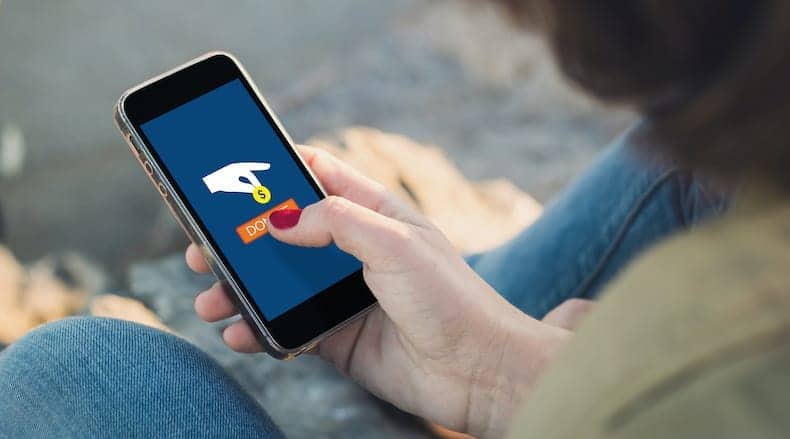
In an increasingly online world, mobile fundraising has become a standard way for nonprofits to raise money. But before your organization can hope to fundraise on the go, you must first have a firm grasp of all of your options.
Not completely sure what mobile fundraising is all about? We’ve got you covered! In this article, we’ll explore all of the major topics that mobile fundraising encompasses. By the end, you’ll be a veritable mobile fundraising expert.
Here’s what we’re going to cover:
- What Is Mobile Fundraising?
- Common Terms
- Mobile Fundraising vs. Text-to-Give
- Types of Organizations
- Questions to Consider
- Getting Started
- Using Social Media
- Why Mobile Giving Is Here To Stay
1. The Definition of Mobile Fundraising
Mobile fundraising, simply put, is the raising of money through mobile devices.
Typically, mobile devices are smartphones (iPhones, Androids, etc.) and tablets (iPads, Galaxy tabs, etc.) that allow users to engage online while on the go. Laptops, although they are portable, are not considered mobile devices. But mobile fundraising can go even further beyond a website that’s mobile responsive.
A few ways your organization can participate in mobile fundraising:
- Text-to-give
- Mobile email
- QR codes
- Mobile crowdfunding
- Text-to-pledge
- Mobile donation pages
- Social media fundraising
As you can see, there are several major options, and within those options, there are dozens of different avenues to explore.
2. Common Mobile Terms and Definitions
When you’re exploring all of the avenues that mobile fundraising has to offer, it’s important that you’re able to speak the language. The following definitions should help you with any situation you come across.
Mobile-responsive
A mobile-responsive design is one that works just as well on a mobile device (phone or tablet) as it does on a laptop or desktop.
Usually, mobile-responsive websites feature:
- Easy-to-press, large buttons
- Vertical design
- Larger fonts
- Fewer blocks of text
- Short loading times
The goal is to avoid donors having to pinch and zoom and swipe in order to donate.
QR code
QR (Quick Response) codes are essentially like barcodes. They’re scannable images that bring the user straight to a website or donation page. Often, they can be found on flyers, posters, and other promotional materials.
Below is an example of a piece of direct mail that features a QR code:
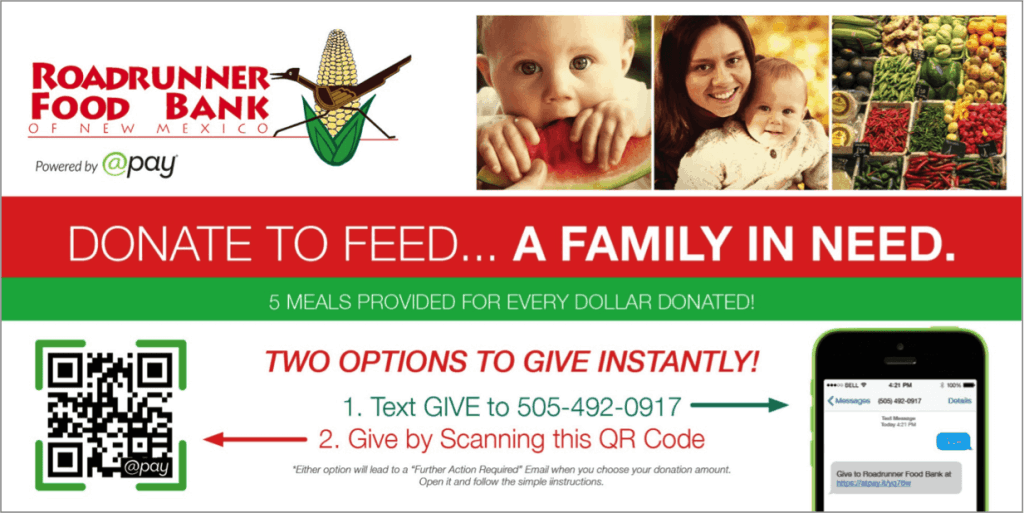
This particular QR code brings the user to a mobile donation page, but you can also use QR codes to promote informational pages.
Crowdfunding
Crowdfunding, also known as peer-to-peer fundraising or social fundraising, is a way of raising money by having existing donors fundraise on behalf of your organization.
Mobile peer-to-peer fundraising has made raising money on the go easier than ever before. Donors need only text, email, or post about their crowdfunding efforts to succeed.
Tokenization
Tokenization is a complicated process, but it’s a simple concept.
Tokenizing information makes it so that no one can de-code sensitive information, such as credit card info. It helps prevent identity theft as well as fraudulent purchases. A reputable mobile fundraising platform provider should work with a payment processor that tokenizes information in order to ensure the highest level of security.
Authentication
Authentication is another way of protecting mobile donors’ information. It also prevents fake accounts from spamming your organization.
To authenticate a donor, all you need to do is to confirm their identity with a second form of identification. For instance, if your donors are texting to donate, you may want to ask for their email address to verify the validity of the transaction.
PCI-compliance
PCI-compliance is the adherence to a set of standards set forth by the Payment Card Industry. When you’re researching different mobile fundraising platform providers, make sure that you’re on the look-out for PCI-compliance as a standard.
3. The Difference Between Mobile Fundraising and Text-to-Give
Many people like to use the terms “mobile fundraising” and “text-to-give” interchangeably. But the truth is, they’re different. Text-to-give is one way to participate in mobile fundraising – just not the only way.
Mobile fundraising is everything from mobile email fundraising to QR code promotions. Text-to-give part of mobile and fundraising and it’s just like it sounds – texting to donate.
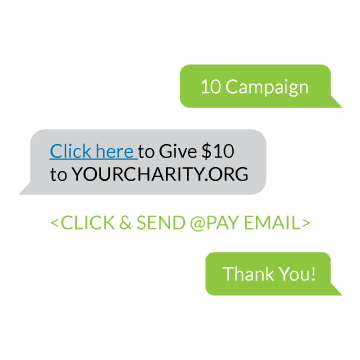
There’s also a misconception that text-to-give is only for the millennial generation. People assume that just because millennials (teens and young adults) love to text that they’re the only ones who would be interested in text-to-give.
The fact is: the average text-to-give donor is 49-59 years old and is college-educated.
4. Types of Organizations that Use Mobile to Fundraise
Knowing the different types of organizations that use mobile methods to fundraise may help your organization decide whether or not it’s right for you. The great thing is that nonprofits across dozens of industries are already using mobile fundraising to achieve their goals.
- Faith-based organizations. Ministries, churches, and other religiously affiliated groups love to use mobile giving to raise money for their good works. Many churches also love to use text-to-give and other means of mobile fundraising when they’re in the midst of capital campaigns.
- Educational nonprofits and schools. Teachers and parents alike use mobile crowdfunding pages to raise funds for their schools. Educational nonprofits also love to use peer-to-peer to spread awareness and raise money.
- Arts, culture, and humanities organizations. Many theaters and museums have mobile-friendly donation pages that they encourage patrons to use in support of the fine arts.
- Animal rights groups. Shelters and animal rights groups alike use mobile-friendly emails to raise money and awareness for animals in need.
- Disaster relief organizations. When disaster strikes and help is needed immediately, many relief organizations rely on mobile donations to fund efforts quickly.
- Political candidates. Even though they’re not nonprofit organizations, they are stellar examples of how organizations and individuals can incite change one small donation at a time.
- Environmental advocacy groups. Raising awareness and funds for the environment can be difficult, unless of course you have a solid mobile fundraising strategy.
As you can see, just about every kind of organization (nonprofit or otherwise) stands to benefit from mobile fundraising.
5. Questions to Consider Before Getting Started
If you’re considering mobile as the next phase of your overall fundraising strategy, there are some very important questions you need to be able to answer first.
Who will be in charge?
This question probably needs to be answered sooner rather than later. Whether you have a team or just one member of your organization heading up your mobile fundraising campaign, it’s important to keep leadership consistent. With one person leading the charge, you’ll have less miscommunication and confusion, and more collaboration and ultimate success.
What type of mobile fundraising will you use?
You know your organization inside and out. You know your donors, and hopefully you know their preferences. Use this knowledge to decide what types of mobile fundraising work for you — and which ones aren’t quite right.
How will you manage your data?
With any mobile fundraiser, you’ll no doubt experience a major influx of new donor data. How you choose to incorporate it into your existing data management system is vital to your success. Data integration is the first and most important step in managing your donors for better follow-up and increased donor engagement.
What data will you track?
Speaking of data, mobile fundraising has its own set of key performance indicators (KPIs) that your organization should be tracking. Ultimately, the metrics that you choose to track are up to you, but some common data points to keep an eye on are your mobile email conversion rate, text-to-give donation size averages, and the general return-on-investment of your efforts.
Where will you launch your campaign?
This question stumbles into legal territory. As you may or may not know, in order to fundraise online or via mobile devices, you may need to register your fundraiser in multiple states. It’s possible that you can avoid this hassle, but if you want to stay on the safe side of the law, it’s best to cover your bases. Take a look at the Charleston Principles before you decide where to register your mobile fundraising campaign.
When should you ask for more info?
As we mentioned earlier, your organization will likely experience a flood of new donor information. That said, you won’t be able to piece together a full picture of each of your donors just based on their name, email address, and phone number. You won’t be able to tell which donor is potentially can potentially give a major gift. That is, unless you conduct some research either in the form of donor surveys or prospect research.
Answered all these questions? You’re ready to get started with mobile fundraising!
6. How to Get Started
Now that you’ve considered all of the critical questions (and you know all the relevant lingo), you’re ready to get started. Here are the most necessary steps to launch a successful mobile fundraising campaign:
Make sure you’re ready for mobile.
In order to make sure that you’re ready for a mobile fundraiser, you first want to ensure that your website and donation page are mobile-responsive.
From there, you’ll need to determine what mobile giving platform will work best for what you’re trying to accomplish. A few things to consider include how the platform will integrate with you donor database, if it has the social media outreach tools you need, and if it includes functionality that will grow with you as you increase your mobile efforts.
Incorporate mobile into your strategy.
As with any other fundraising avenue, mobile fundraising will need to be incorporated into your nonprofit’s overall strategy. Of course, that will look slightly different for everyone.
It’s important to keep in mind that mobile fundraising is just another tool in your nonprofit’s toolkit. You can choose to use it as often or as seldom as makes sense for you.
Double-check donor info.
When you’re launching a mobile fundraising campaign, it’s especially important to have accurate donor information. Of course, once they donate via mobile, you’ll have their updated info, but before that happens, you need to be able to reach them in the first place!
To make sure you have accurate donor info, consider sending out a survey asking them to update their info for you. Or you can also send out an email blast and track the results to see what emails bounce back, who opens your email, and who leaves it untouched.
Expand your network.
One of the best ways to spread the word about your mobile fundraising campaign is through your existing donor base. But how do you involve your current donors in your upcoming plans?
Peer-to-peer fundraising, of course!
Select willing participants to take part in your mobile fundraiser. Give them the necessary tools to fundraise on your behalf. Before you know it, not only will you have raised more money for your cause, you’ll also have reached new potential donors and expanded your donor base— all at the same time!
Set realistic goals.
Ultimately, a mobile fundraiser is just like any other nonprofit fundraiser. The work you put into it will equal the results that you see in the end.
An important step in any successful mobile fundraiser is to set your expectations reasonably. Remember that mobile fundraising is marvelous, but it’s not miraculous.
Announce and advertise your plans.
With your goals firmly set, it’s time to start marketing your mobile fundraising campaign. Spread the word about your mobile fundraising campaign through a variety of tactics:
- Take advantage of social media
- Create flyers and posters
- Advertise on bus stops and billboards
- Email your existing donors
- Make phone calls to your supporters
Here’s a great example of a nonprofit that used a bus stop to get the word out:
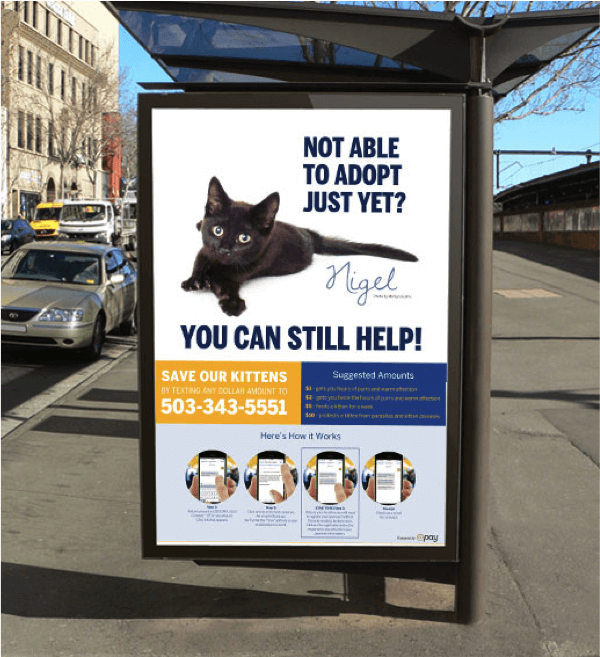
As you can see, they’ve made their call to action obvious, used images to incite action, and made the next steps easy to follow. Seems simple, right? Your nonprofit can do the same!
Launch, track, and improve.
This final step is an ongoing one.
As long as you’re hosting your mobile fundraiser, you’ll want to keep an eye on your progress by tracking key metrics. Use this information to improve your strategy over time, and you’re bound to see positive results in the long-run.
7. How to Use Social Media to Enhance Your Fundraiser
Because so much of social media is mobile-focused (83% of social media sites are accessed primarily through mobile devices), it’s easy to see why these two go hand-in-hand.
But how do you use social media wisely to bolster your nonprofit’s success?
We’ve got some tips and tricks for each of the major four platforms:
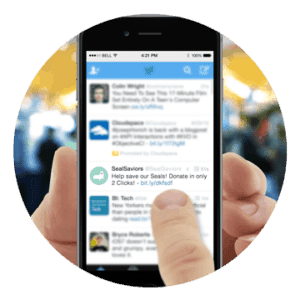
With Twitter, you only get 280 characters to make your message, so choose wisely! You should also keep your next steps as clear and obvious as possible. A terrific example is this post by Seal Saviors:
They highlight the importance of donating sooner rather than later, and they provide an easy-to-follow link to their donation page.
The key to a perfect post on Facebook is to include an image of some kind because posts with images on Facebook yield 94% more engagement than posts without.
Snapchat
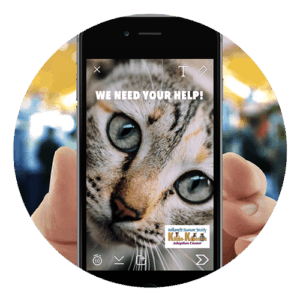
Snapchat images and videos only last a few seconds. So you have to make every second count. Make your statements bold, interesting, and memorable.Take, for instance, this stellar snap from the same humane society:
There’s no link, and no info about the mobile fundraiser, but that’s okay. They’ve made their statement and presented their brand. With any luck, their adorable close-up of a kitten’s face will entice people to look up their organization and learn more. Snapchat is a great starting point for getting people interested in your cause.
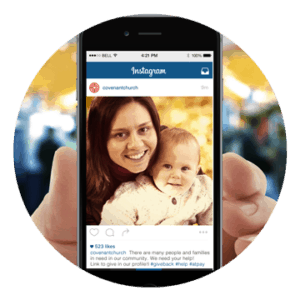
As you may or may not know, Instagram is a forum for sharing images. As such, the focus for marketing your mobile fundraiser on Instagram should be curating the best photos that tell a story. The Covenant Church does an awesome job of using Instagram to promote their work in the community:
Because you can’t provide a link within an individual post in Instagram, this example points people to a specific link in their Instagram profile bio. This makes it easy for people to get to your campaign page and give.
8. Why Mobile Giving is a Trend that’s Here to Stay
If you’re still concerned that mobile giving is just a passing craze, read on. We’ve collected some of the most concrete reasons that mobile is a trend that’s here to stay.
Mobile fundraising is easy for donors and for nonprofits.
Few things are simpler than sending a quick text to a friend. That same principle applies when that text is a donation to charity. Mobile fundraising — whether it be text-to-give, mobile email donation buttons, or mobile-responsive web pages — makes giving to nonprofits as simple as tying your shoes. Not only is it super intuitive for donors, but it’s also incredibly straightforward for nonprofits.
Mobile fundraising is a secure way to give any time, anywhere.
Because there are so many different safety and security measures built into mobile fundraising platforms, donors and nonprofits seldom have to worry about fraudulent transactions. Measures such as 2-factor authentication, PCI-compliance, and tokenization all contribute to the overall security of mobile giving. Because as we all know: a secure way to give is a lasting way to give.
Everyone, young and old, loves to give on the go.
As we mentioned earlier, most people assume that mobile giving is a young man’s game. The truth is, people of all ages give online and through mobile devices. In fact, donors over 65 are just as likely to give online as their younger counterparts. When you’ve got all major demographics on board with a trend, you know it’s bound to last.
It’s already done a significant amount of good in the world.
The final reason that mobile giving is a trend that’s clearly here to stay: it’s already helped thousands of organizations meet their goals and change the world. From the text-to-donate disaster relief fund that helped Haiti recover from the devastating earthquake to Alicia Keys’ mobile campaign to change lives in Africa, mobile fundraising has made a huge impact already.
Now that you’ve got the basics down, you’re ready to get out there and start tackling your very own mobile fundraising campaign.
Whether you’re launching a text-to-give fundraiser or mobilizing your existing donation page, mobile fundraising makes raising money on the move easier than ever before. Just remember that the key to mobile success is the same as any other fundraising effort — the results you get are directly correlated to the time and intentionality you put in.
What are you waiting for? There are so many avenues to explore!
Schedule a live demo with our partner Bloomerang, and we’ll show you how easy it is to create and automate reports, utilize online and offline fundraising tools, quickly integrate and access all your data, and ultimately create more time to engage your donors.